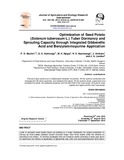| dc.identifier.citation | Muchiri, P D., Gathungu, G K., Njogu, M K., Nyankanga, RO and Ambuko, J., Landeo, J A (2015). Optimization of seed potato (solanum tuberosum L.) Tuber dormancy and sprouting capacity through integrated gibberellic acid and benzylaminopurine application. Journal of Agriculture and Ecology Research International 4(4): 188-198 | en_US |
| dc.description.abstract | Aims: To determine the relative abundance and diversity of insects on twenty-two accessions of eggplants, as a guide to instituting control measures against unacceptable damage of egg plants grown under field conditions in the Coastal Savannah agro-ecological zone of Ghana.
Study Design: The experimental treatments were deployed in a Randomized Complete Block Design (RCBD), replicated three times.
Place and Duration of Study: Nuclear Agriculture Research Center (NARC) farms and the laboratories of Radiation Entomology and Pest Management Center (REPMC) of Biotechnology and Nuclear Agriculture Research Institute (BNARI), between September 2012 and November 2012.
Methodology: The fields were divided into three replicates each containing twenty-two different accessions of eggplant S. macrocarpon, S. gilio GH8769, S. aethiopicum, S. gilio GH8771, Nroroye F, Ntorewa K, S. gilio GH8770, S. melongena GH 3949, Ntropo B, Ndroshye E, Ndroshye C, Ndroshye, Nroroye A, Black beauty, Nroroye G, Ntropo K, Ntropo I, Sammy, Ntropo G, Nroroye D, Ntropo H, Nroroye J. The seeds were sown in a nursery and transplanted 35 days after germination to an experimental plot measuring 40 m x 11.4 m in the centre of one acre area so that the experimental plot was surrounded by a homogeneously managed terrain. The experimental treatments were deployed in a Randomized Complete Block Design (RCBD), replicated three times. Each replicate was allotted a plot size of 19.8 m x 8.4 m. Each sub-plot planted to one accession consisting of 22 plants at a spacing of 0.9 m x 0.6 m. Plots were separated by a distance of 2 m. Random sampling technique was used on weekly basis to study the relative abundance, diversity and behaviour of the insect species on the accessions.
Results: Fifteen different insect species were identified on the twenty two accessions of eggplant from the vegetative through to the maturity stage. These comprised three beneficial insects (C. lunata, Camponotus sp. and M. religiosa) and twelve pests (A. craccivora, B. tabaci, B. invadens, Dysdercus sp., G. compestris, L. orbonalis, P. mali, Podagrica sp., O. virudulus, N. viridulus, Phenacoccus sp. and Z. variegatus). Their relative abundance ranged from 0.20– 8.78% for beneficial insects and 0.03 – 45.63% for pests. The highest abundance of insects were found on the accessions Ndroshye (14.09%) and Nroroye G (9.80%). Nroroye F registered the highest diversity of insect species, while Ntropo B and Sammy recorded the least diversity.
Conclusion: There was high abundance of insect species (65.85%) on the field of study. High diversity of insect species was noted and this could be a guide in instituting control measure before pest numbers go beyond the economic thresh-hold level. | en_US |

